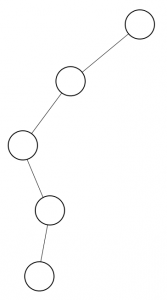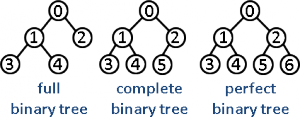BINARY TREE
 <skewed Binary tree
<skewed Binary tree
- Node at the top is called as root.
- A line connecting the parent to the child is edge.
- Nodes that do not have children are called leaf.
- Nodes that have the same parent are called sibling.
- Degree of node is the total sub tree of the node.
- Height/Depth is the maximum degree of nodes in a tree.
- If there is a line that connects p to q, then p is called the ancestor of q, and q is a descendant of p.
- Binary tree is a rooted tree data structure in which each node has at most two children.
There are 4 types of Binary Tree:
- Perfect Binary Tree
- Complete Binary Tree
- Skewed Binary Tree and
- Balanced Binary Tree
Perfect :
- This Binary Tree has the same depth for every level
Complete:
- This Binary Tree is almost perfect except the last level.
- Perfect Binary tree is also a Complete Binary tree
Skewed :
- Every level only has one node.
Balanced :
- binary tree in which no leaf is much farther away from the root than any other leaf (different balancing scheme allows different definitions of “much farther”).
Properties of Binary Tree
- Every level of the binary tree, has its own maximum nodes.
- Those levels start from 0.
- In level 0, maximum 1 node.
- In level k, maximum 2^k nodes.
How to count the maximum nodes in a tree according to its height:
height -> 2^(h+1) – 1
Maximum nodes in binary tree of height 3 is
2^4 – 1 = 15
Maximum height = n-1
Minimum height = 2log(n)
Sources : Binus University


